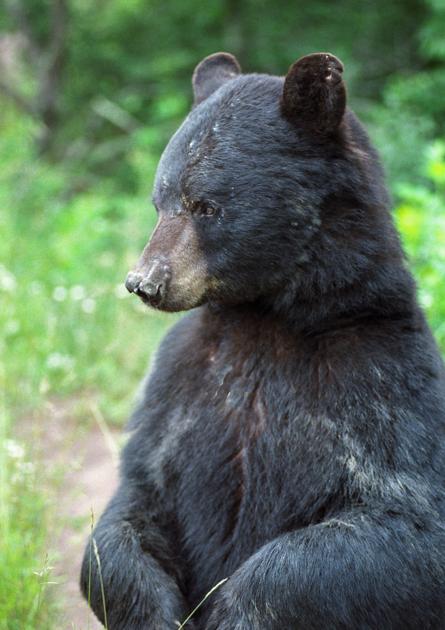West Virginia’s bear hunters might need to adjust their plans for this fall.
Division of Natural Resources officials unveiled this year’s slate of proposed changes to the state’s hunting and fishing regulation changes at Sunday’s quarterly meeting of the state Natural Resources Commission. The most dramatic proposal would reshuffle some of early firearm seasons for black bear, particularly in Boone, Fayette, Kanawha and Raleigh counties.
Under the proposal, hunters in those counties would receive 10 extra days of hunting. The season would be split into two parts, Aug. 28 to Sept. 6 and Oct. 30 to Nov. 5. By comparison, last year’s season ran from Oct. 2 to Oct. 8.
Colin Carpenter, the DNR’s bear project leader, said the high number of bear nuisance complaints in those counties indicates that the population needs to be thinned.
“Last year, 47% of the state’s nuisance complaints came from those counties,” Carpenter told commissioners.
A similar overpopulation problem existed in Logan, Mingo, McDowell and Wyoming counties during each of the past two years. By opening the season in late August and providing extra days of hunting, wildlife officials were able to reduce the bear population there.
This year’s proposed season reflects that success. The start of the season will be pushed back a couple of weeks, and the season will be split into two parts. The first segment will run from Sept. 11 to 17, the second segment from Oct. 2 to 8.
If approved by the commission, this year’s season in those counties will be two days shorter than last year’s.
Most of the rest of the DNR’s recommendations involved lengthening or adding counties to existing seasons.
The bear firearm season without dogs held concurrently with the state’s October antlerless-deer season saw the largest increase. Last year, 29 counties were open for the three-day hunt. This year, 51 counties will be open.
“Basically, we just added the rest of the counties in which firearm hunting for deer is allowed,” Carpenter said. “It sounds significant, but last year during that season, hunters killed just 38 bears in the 29 counties that were open.”
In addition to those changes, DNR officials asked the commission to give cities and homeowners’ associations the ability to institute urban bear-hunting seasons.
Bear nuisance complaints have risen in Charleston, Morgantown, Beckley and other municipalities located in areas with high bear populations. DNR wildlife chief Paul Johansen said the proposal would give city and town governments the ability to allow bow and crossbow hunting for bears within their corporate limits.
“Bears are particularly problematic in cities because they become habituated to humans and the sources of food found near people’s houses and businesses,” Johansen added.
Urban seasons for deer have helped reduce whitetail populations in several cities throughout the state, and Johansen believes urban bear seasons would do the same.
The state’s fall turkey-hunting season might also change this fall.
DNR officials didn’t formally propose a change to the season, but they plan to put on their annual “sportsman questionnaire” a question that asks turkey hunters if they’d like to see one week of the four-week season moved into January.
Specifically, they asked if hunters would prefer to move the first week of the 2021 season (which would be Oct. 9 to 17) to Jan. 17 to 23, 2022; move the last week of the season (which would be Nov. 8-14) to Jan. 17 to 23; or leave the season in its traditional time frame.
The DNR did formally ask the commission to add turkey hunting to the four-day Mountaineer Heritage primitive-weapons season, which is currently open only to bear and deer hunting. The proposal would allow turkey hunters to use muzzle-loading shotguns or rifles as well as longbows and recurve bows.
Wildlife officials proposed only slight changes to the state’s deer seasons. Under the proposal, three counties — Pocahontas, Wayne and Mason — would move to more liberal antlerless-deer regulations; four counties — Preston, Cabell, northern Kanawha and Boone — would move to more conservative regulations.
The commission doesn’t usually act on proposals during the winter meeting, but they made an exception on Sunday when they revisited a 2020 decision in regard to coyote hunting.
At that time, they voted not to allow a proposal that would allow people to hunt coyotes at night during the months when deer seasons are open.
On Sunday, at the urging of DNR director Steve McDaniel, they reversed their decision. McDaniel said the decision would apply only to private lands, and would require hunters to contact their local DNR office to inform the Natural Resources Police where and when they intended to hunt. He said the calls would need to be made at least two days in advance of the hunt to allow time for the requests to be processed.
The commission voted 6-1 to adopt McDaniel’s decision. Commissioner Tom Dotson of Greenbrier County was the lone dissenting vote.
The commission also heard the DNR’s proposals for fishing-regulation changes, which were mostly minor.
One significant change, if approved, would add five-sixths of a mile of stream to the Fly Fishing Only section of Second Creek in Monroe County. According to DNR fisheries chief Mark Scott, the private landowner who controls that stretch agreed to allow anglers to fish it.
The new segment would begin at the lower end of the current fly-only section and extend downstream from there.
Another significant change would impose a 10-fish daily creel limit for sunfish at Mason Lake in Monongalia County and at Teter Creek Lake in Barbour County. Under the regulations, only five of the fish kept could measure more than 8 inches in length.
Scott called the regulation “a pilot program” designed to help the DNR establish larger-sized panfish populations in selected fisheries.
The DNR’s other fisheries proposals included:
• Changing the trout delayed harvest regulation. Currently, streams managed for delayed harvest are open to harvest from June 1 to Sept. 30; under the change, they would be open from April 1 to Oct. 31.
• Establishment of a six-fish aggregate creel limit for sauger, saugeye and walleye on the Kanawha River from the Buffalo Bridge upstream to the Marmet Locks. Only two of the fish could be walleye, and the walleye would have to measure 18 inches or longer.
• Establishment of a 20- to 30-inch protected slot limit for walleye in Cheat Lake and the Cheat River. The creel limit would be eight fish a day, only one of which could be larger than 30 inches.
• Establishment of a four-fish limit, only one of which could measure more than 35 inches, for flathead catfish on the entire length of the Monongahela River.
• Removal of the 15-inch minimum size limit on walleye in Tygart Lake and in the Tygart River from Valley Falls upstream to Tygart Dam.
• Removal of catch-and-release trout regulations on a 0.9-mile section of Shavers Fork in the Stuart Recreation Area.
• Elimination of the Woodbine children’s and handicap fishing area on the Cranberry River.
• Addition of tiger trout to the list of species to be considered under aggregate limits for trout.
All of the DNR’s proposals will be open to public comment during the weeks leading up to the commission’s next meeting on May 2. The commission is expected to act on the hunting proposals in May, and on the fishing proposals in August.
Credit: Source link































